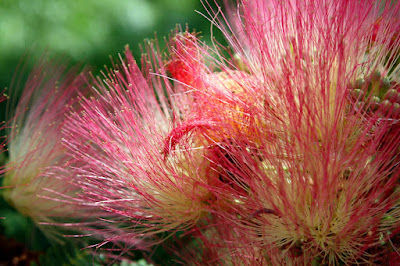The Mimosa Tree shown in the above picture is a few blocks from our house and I've always admired it from a distance, but had never taken the time to photograph it ... until yesterday. I was both amazed and delighted with what I saw through my lens, and don't think I'll ever look at a Mimosa tree the same way again.
But before I share the pictures, I'd like to share a few facts I learned about Mimosas:
- Originally from China, the Mimosa (Albizia julibrissin), was introduced to the United States in 1745, and is cultivated primarily for use as an ornamental, mainly because of its fragrant and showy flowers.
It is also known as Silk Tree, Sleeping Tree (because its leaves slowly close during the night and during periods of rain, the leaflets bowing downward as if the tree were sleeping); and Powder Puff Tree, because its flowers resemble a cheerleader's pom-poms.
Due to its ability to grow and reproduce along roadways and disturbed areas, Mimosas are considered in some areas of the country to be invasive.
The Mimosa tree can grow up to 40 feet tall in the South, and blooms from early to mid-summer.
But enough facts about Mimosa Trees — let me show you why I found everything about this tree amazing -- from its showy flowers and delicate leaves to its graceful branches bending low.
The tree I photographed is probably 20 feet tall and has a canopy of approximately 30 feet, and as I stood under its branches and looked up, its leaves looked like delicate little ferns blowing gently in the breeze.
But the most interesting feature of the tree is its flowers, and although they are showy from a distance, they are truly spectacular up close!
The feathery "pom-poms" are the stamens, and if you click on the pictures, you can see their tiny green tips, which remind of fiber optic filaments ...
I hope you enjoyed seeing a Mimosa tree up close as much as I enjoyed capturing this one with my camera. If there is a tree in your neighborhood, stop by and take a closer look ... they are truly amazing.




































9 comments:
my all time favorite tree....we
would pretend the flowers were our powder puffs....or wear thm in our hair....great post
We had one in our yard as a child...brings back great memories!
Exactly right---simply perfect.
These are so evocative of all my Summer Days, I can smell that sweetness, and feel the tickle of the pouf against my nose.
As always, I stand amazed at your gift for capturing absolute beauty.
Oh yes! I DID enjoy seeing it up close through your lens... we had one years ago, but it died.
They are the prettiest shade of pink, aren't they??
Have a wonderful evening!
Jenni
Mimosa has small leaves and its flower is just awesome since it is beautiful.But the main role is of root bark of mimosa that is used for making medicines
Mimosa trees are not affected by a lot of pest. However, they do harbor webworms, which are not usually a serious threat to mature trees. The webworms can quickly strip a young tree of its foliage.
Mimosas are easy to care for and make rather interesting bonsai due to their rather unique foliage and showy flowers. However, due to the size of their foliage they work best in larger bonsai forms such as kifu and dai.
Mimosa trees have fine,fern-like leaves and white to pink blooms attractive to butterflies,bees and birds.I really like pink flowers of mimosa.
The mimosa seeds can be strong with a needle and thread just before they harden and they make beautiful natural necklaces and bracelets and earrings.
Post a Comment